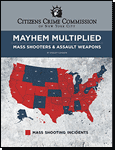
|
|
FROM POLICE FORCES TO POLICE SERVICES:
A New Framework for Policing in the U.S. (2021)
The crisis around police legitimacy requires our full collective efforts to resolve. Its impact is immediate, troubling, drives a deeper wedge between police and communities and is disruptive of crime reduction and prevention. No one benefits. We are seeing sharp rises in shootings and murders, and legislative bodies reducing funding to police agencies - the very agencies charged with crime reduction.
In this report we call for the reorientation of policing in the United States, from Police Forces to Police Services.
» Citizens Crime Commission: From Police Force to Police Services - A New Framework for Policing in the U.S. report
|
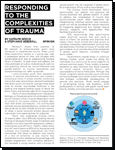
|
|
Responding to the Complexities of Trauma (2018)
Justice-involved youth are suffering harsh, too-frequent experiences of trauma across environments/contexts/settings. These severe experiences can lead to complicated grief, feelings of betrayal, and difficulties identifying and maintaining healthy relationships. When making decisions that impact youth, we must listen to and include youth voices. Listening to youth will provide critical insights on how to engage in strategies that work to heal, rather than unintentionally harm our already vulnerable young people. The current article was published as a part of Orange U Going's Solutions to Youth Criminalization magazine and conference.
» read the article
|

|
|
E-Responder Evaluation: Cultivating Resilience and Sociopolitical Empowerment (2017)
E-Responder was developed by the Crime Commission in partnership with NYU and NYC Cure Violence to intervene with youth in new, virtual spaces of conflict. This third and final evaluation demonstrates that E-Responder had significant effects on two critical outcomes, both of which are predicted to facilitate positive long-term results for youth: (1) resilience, by building on youths' existing strengths, coping skills and empowering them to face adversity and grief; and (2) sociopolitical awareness, by providing youth with the vocabulary and opportunity to discuss topics such as inequality, oppression, privilege and race. The findings from the three research briefs demonstrate the effectiveness of E-Responder as an intervention engaging youth online, where they are highly involved and literate and moreover, that E-Responder is more than an intervention model; it is an early-prevention strategy.
» read the report
|

|
|
When Your Best Friend is Murdered: Experiences of Grief and Trauma with Crew-Involved Youth (2017)
Grief and trauma are critical drivers of violence and play significant roles in why young people become involved in crews, how conflicts become seriously violent, and underlying reasons for engaging in retaliatory violence. In order to cope with trauma and complicated grief, crew-membership and violence emerge as ways to receive social support, emotional release, safety, and purpose. In order to ensure we are meeting youths' needs holistically and preventing violence in the long-term we must include these life experiences when developing programs and policies.
» read the report
|

|
|
E-Responder Poster: Interruptions of Risky Online Behavior De-escalate Violent Conflict (2017)
E-Responder was presented at the Society for Community Research and Action (SCRA) 2017 Biennial Conference "Transformative Community Psychology" in Canada to discuss the innovative approach of conducting intervention through social media, research study, and results.
» read the poster
|

|
|
E-Responder Evaluation: Youth Leadership Program Results (2017)
E-Responder was developed by the Crime Commission in partnership with NYU and NYC Cure Violence to intervene with youth in new, virtual spaces of conflict. The Youth Leadership Program supports this mission by providing youth the opportunity to learn, build, and enhance life-skills that prevent violence and promote long-term success. In this second evaluation, results demonstrate the effectiveness of the Youth Leadership Program and the positive impacts the program had on youth.
» read the report
|

|
|
Social Media as an Opportunity for Service (2017)
The high visibility of harmful behavior, trauma, grief, and emotional distress on social media gives service providers the opportunity to know exactly who is at the highest risk for committing or being victimized by violence and in greatest need of service. We need to capitalize on this opportunity by giving anti-violence professionals a new method of responding to risky social media use. As modes of communication have changed to favor online spaces, so too must our interventions.
» read the report
|

|
|
E-Responder Evaluation: Interruption Toolkit Results (2017)
Increasingly, real-world violence follows fights started online, as social media amplifies and accelerates conflict. Results from the Citizens Crime Commission's E-Responder pilot study with NYU and NYC Cure Violence demonstrates the effectiveness of our innovative digital intervention in preventing virtual and real-world violence between youth involved in gun violence.
» read the report
|
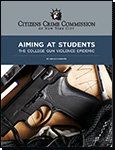
|
|
Aiming At Students: The College Gun Violence Epidemic (2016)
Gun violence at U.S. colleges has exploded in recent years, increasing from just 12 incidents during the 2010-2011 school year to nearly 30 in 2015-2016 school year—and the number of shooting victims has also spiked to a disturbing level. Given that studies have shown that gun violence victimization and mere exposure to gun violence can lead to poor academic performance, disruptions at school or work, relationship problems, and lasting emotional distress — and, of course, the physical danger that shootings put students in — it is clear that the public needs to become more aware of campus safety. As our research shows, between the 2001-02 and 2015-16 school years, 437 people were shot, including 167 killed and 270 wounded, on or near U.S. college campuses. An estimated 2.5 million students were enrolled at the 142 colleges where the 190 recorded shootings occurred, and, thus, were directly or indirectly exposed to gun violence.
» read the report
|

|
|
How Human Behavior and Decision Making Expose Users to Phishing Attacks (2016)
Approximately 95% of recent high-profile security breaches were the result of preventable human error and behavior weakness. In this report, the Crime Commission provides an overview of the potential impacts of phishing on victims, the tactics used in phishing scams, and the preventative measures users can implement to protect themselves and their families, friends, schools and employers. Given that it only takes one email to fall victim to a cybercriminal's attack Internet users must be aware of the ways their behaviors and decision making expose them to cyber-threats.
» read the report
|
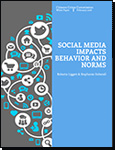
|
|
Social Media Impacts Behavior & Norms (2016)
On social media, a recognized set of norms have not caught up with the speed in which social media has been adopted into our lives, leading to ambiguity concerning what behavior is appropriate. This paper explores the unique features of social media and their impact on behavior and social norm creation. Understanding the unique landscape of social media will assist others in understanding why problematic behavior—such as cyberbullying, threats, prejudice, violence, and harassment—continue to be pervasive in this space and what steps stakeholders can take to change norms and create a positive online environment for expression, engagement, and connection.
» read the report
|

|
|
Testimony: The Laws Governing the Age of Adult Criminal Responsibility (2016)
The Crime Commission's testimony to the New York State Legislature in support of raising the age of criminal responsibility to 18 years old.
» read the testimony
|
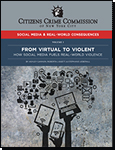
|
|
Social Media & Real-World Consequences (2015)
Social media has become a part of everyday life. All types of real-world behavior are now showcased online—including criminal behavior, bullying, threats and the glorification of violence. Increasingly, youth associated with antisocial peer groups—such as neighborhood-based "crews" engaging in violent rivalries—use social media as a tool to create criminal opportunities and amplify conflicts. Unfortunately, in many cases, this type of social media usage can lead to real-life violence or other serious ramifications, such as arrest. The Crime Commission's series, "Social Media & Real-World Consequences", provides an overview of the ways youth are communicating on social media, the associated risks of these communications turning into real-world violence, and the range of legal, educational and professional consequences youth may face in the real-world.
» read Volume 1: From Virtual to Violent
» read Volume 2: Responding to Social Media Norms
|
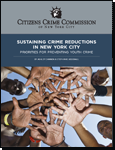
|
|
Sustaining Crime Reductions in New York City: Priorities for Preventing Youth Crime (2015)
New York City's success at driving crime down to unprecedented lows has ushered in a new era of policing: one in which more time is spent preventing crimes than reacting to them. In this report, the Crime Commission recommends that to sustain these crime reductions, the police and the growing body of responsible stakeholders should prioritize efforts that address youth victimization and exposure to violence; develop the youth workforce; enhance legitimacy; break down silos to improve coordination; and address the negative impacts that state and local policies have on youth.
» read the report
|
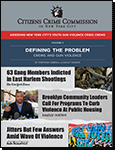
|
|
Assessing New York City's Youth Gun Violence Crisis: Crews (2015)
The success or failure of community strategies to address the youth gun violence crisis is often attributed in part to how well the problem is understood and diagnosed. With support from The New York Community Trust, the Crime Commission has undertaken an analysis of youth gun violence and crew activity — violent turf rivalries among less-organized, smaller and normally younger groups than traditional gangs — in select New York City communities. Our initial findings from available data, existing research and interviews with stakeholders are presented in a series of papers titled, Assessing New York City's Youth Gun Violence Crisis: Crews:
» read Volume 1: Defining the Problem
» read Volume 2: CompStat for Violence Prevention Programs
» read Volume 3: Responding to the Problem
|
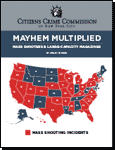
|
|
Mayhem Multiplied: Mass Shooters & Large-Capacity Ammunition Magazines (2014)
Mass shootings have taken place consistently throughout American history, in every region of the country. Over the last 30 years, however large-capacity ammunition magazines—which hold more than 10 rounds—have proliferated, allowing assailants to become much more destructive. A Crime Commission analysis shows, the results have been deadly for Americans.
» read the report
|

|
|
Testimony: The Laws Governing the Age of Adult Criminal Responsibility (2013)
Crime Commission Director of Public Policy Ashley Cannon testifies before NY Assembly in support of raising the age of criminal responsibility to 18 years old.
» read the testimony
|

|
|
Mass Shooting Incidents in America: 1984-2012
Mass shootings are a unique feature of American life which have occurred consistently throughout history in every region of the country. The increased lethality of such incidents is made possible by the use of large capacity ammunition magazines (defined as more than 10-rounds) which enable a shooter to rapidly fire off as many as 100-rounds without having to reload the firearm. Designed for military use to kill greater numbers of people more effectively, large capacity ammunition magazines have facilitated some of the worst mass murders ever committed in the United States. As these incidents occur in every region of the country, restricting civilian access to these weapons is not a state specific problem. The federal government needs to take action to protect all Americans by reinstating the ban on large capacity ammunition magazines.
» Mass Shooting Incidents in America
|

|
|
Domestic Terrorism Incidents Post-9/11
Since September 11th, 2001 there have been over 100 incidents of "home-grown" or domestic terrorism in the United States. To provide a valuable resource on this topic, the Crime Commission has compiled an extensive database of incidents including attacks, plots, support for, membership in, or connections with a terrorist organization.
» Domestic Terrorism Post-9/11
|

|
|
A Stalled Farewell to Arms—Reinvigorating the Gun Control Movement
In this article published in the New York State Bar Association's Government, Law and Policy Journal, Crime Commission President Richard Aborn looks at the history of gun violence in America and its impact on legislative efforts to control it, the evolving Second Amendment jurisprudence, and the shifting political landscape, asking what can be done to return the gun political agenda to one grounded in reducing gun violence.
Reprinted with permission from: Government, Law and Policy Journal, Summer 2012, Vol. 14, No. 1, published by the New York State Bar Association, One Elk Street, Albany, NY 12207
» read the article
|

|
|
Fact Sheet: Expanding the Use of DNA in NY:
Convicting the Guilty; Exonerating the Innocent (2012)
The Crime Commission is calling on the state legislature to pass a law to require anyone convicted of a crime in New York to submit a DNA sample to the Databank. Under this new law, individuals convicted of the misdemeanors not currently covered by the DNA Databank law will now be required to provide a DNA sample. By increasing the number of criminals required to submit their DNA, there will be more "cold hits" (matches) on DNA left behind at crime scenes. In addition, the expansion of the databank will prevent crimes from occurring by identifying criminals before they have the opportunity to commit additional crimes.
» read the fact sheet
|

|
|
Testimony: Expanding the Use of DNA in NY:
Convicting the Guilty; Exonerating the Innocent (2012)
Crime Commission President Richard Aborn testifies before NY Legislature in favor of expanding the DNA Databank.
» read the testimony
|

|
|
Fact Sheet: Large-Capacity Ammunition Magazines (2011)
The Crime Commission is calling on Congress to pass legislation to ban large capacity ammunition magazines. This new law would limit the capacity of magazines to 10 rounds for civilian ownership. Restricting the size of ammunition magazines to no more than 10 bullets is common sense. A ban on large capacity magazines would not only reduce the capacity, but more importantly reduce the lethality of firearms. Moreover, we need to protect our police officers, who shouldn't have to confront so much firepower on the street: they deserve better.
» read the fact sheet
|
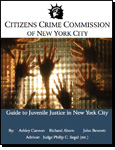
|
|
Guide to Juvenile Justice in NYC (2010)
New York's juvenile justice system has reached a point of extreme crisis. With increasing frequency, reports of fundamental breakdowns throughout the system have come to the public's attention. The city and state governments have responded with substantial reform plans. In light of this increasing attention and the complexity of the juvenile justice system in New York, the Crime Commission has developed a Guide to Juvenile Justice in New York City to enhance the public's understanding of the City's juvenile justice policies.
» read the guide
|

|
|
Police and Public Safety in New York City (2004)
This study of police operations, crime and public safety in New York discusses recent trends in law enforcement including the increased importance of counter-terrorism police work in the post-Sept. 11 environment. It also includes the results of surveying work regarding public perceptions about neighborhood safety, police and police-community relations, and quality of life enforcement. These findings are presented both at the citywide level and also broken down by borough and ethnicity.
» read the report
|

|
|
Crime, Police and the Community (2001)
This report looked at public attitudes towards the police, especially in terms of how the public felt about significant crime reductions that had occurred during the 1990s. It also includes the Commission's analysis of recent trends and its recommendations for further improvements. The appendix contains information about the report's methodology and survey team.
» read the report
|

|
|
Restoring a Safe New York (1990)
This report, released at a time when crime in New York City had reached
alarmingly high levels, warned that unchecked criminal activity posed a
significant threat and made several recommendations to address the
problem. The Commission advised the city to adopt crime-fighting
strategies based on the "broken windows" theory of policing, which
called for law enforcement to move away from reactive 911-based policing
towards a more proactive crime prevention and maintenance of order
approach. It also advised adding 5,000 police officers to the force and
the creation of community courts. In the mid-1990s these recommendations
began to show significant results, leading to New York City's historic
recent reduction in crime and a dramatic improvement in the quality of
life in the community.
» read the report
|



